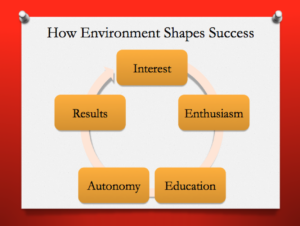
How Environment Shapes Success
Yesterday, Cressey Sports Performance coach Miguel Aragoncillo delivered an outstanding in-service that led to a great discussion of characteristics of our clients who’ve had the best long-term success. Without a doubt, the one that stands out above all else is consistency. If someone continues to show up consistently – all other things held equal – they stand the best chance of making great progress toward their goals, whether they’re performance, aesthetic, or a combination of the two.
The discussion immediately made me think back to a slide from my presentation on long-term athletic development on this year’s Perform Better tour. In this slide, I talked about how the path to success is actually a circle.
Everything begins with having an environment that individuals find motivating and inviting – which drives interest. This might come from them relating to the like-minded training partners, music, unique programming or coaching styles, or any of a number of factors. Very simply, it has to be an environment that drives enthusiasm, the next component of the circle.
Enthusiastic athletes are more open to learning, whether it’s about their unique movement issues or how they approach nutrition. This enthusiasm opens up a window for education.
When you get a motivated, enthusiastic, educated athlete, you’ve set the stage for a greater level of autonomy. When someone has the education and desire to change – but also the independence to do it on their own – you’ve created an optimal scenario for results to take place.
And, the more results you get, the more buy-in you receive in the form of increased interest – and the circle starts anew.
None of this should seem revolutionary, but you’d be surprised at how many individuals try to jump in at the education portion. They assume that everyone who walks in their door is interested and enthusiastic, and that isn’t always the case. This is one reason why I’m always particularly cautious not to overwhelm folks during their initial evaluations; I’m actually far more interested in building rapport and making them comfortable in our environment than I am in telling them all about how they have brutal hip internal rotation or a serious lack of rotator cuff strength.
[bctt tweet=”Initial assessments should start a relationship while tactfully delivering (not forcing) education.”]
I try to view each client in the context of this circle to see how we can best optimize their experience with us and improve consistency. Do we need to do a better job of making them excited about the environment? Or, do we need to build on the enthusiasm they already have with a stronger educational component? Or, do we need to help them come up with strategies to best incorporate the knowledge they have to develop more autonomy to facilitate further progress? At the end of the day, it’s a unique mix for every individual, but this framework can help you to get to the bottom of it.
I’ll leave with a closing thought: when you get a 15-16 year-old athlete who has gotten to the autonomy stage that early in his athletic career, it is an absolute game-changer. These athletes not only follow everything you put on paper to a “T,” but also become even better active participants in the training process. They’re better communicators who ask good questions and help you to develop the best programming and coaching approaches to get them results quicker. And, when you combine this high motivation and early independence with someone who is a gifted natural athlete, you can see absolutely incredible progress.



